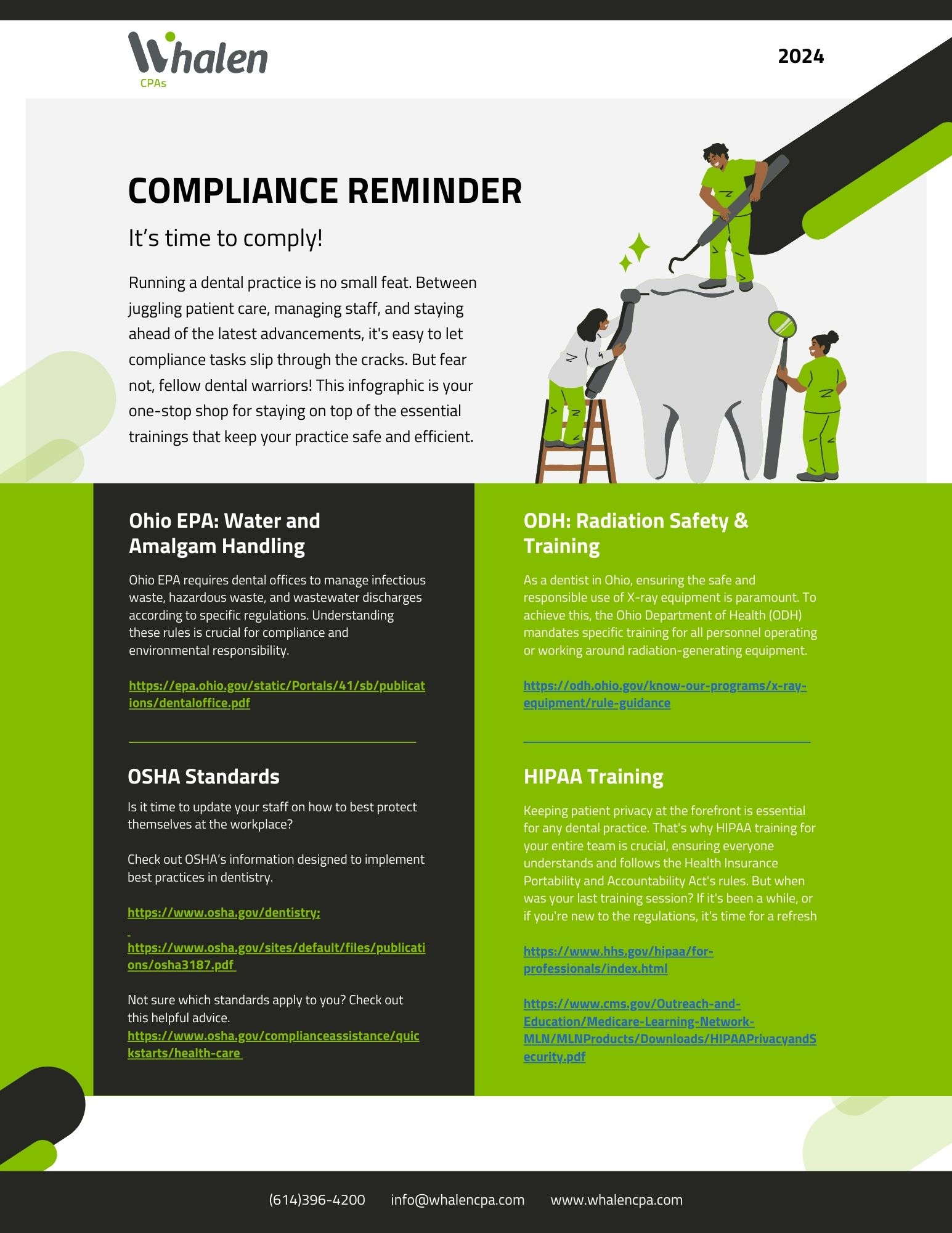News & Tech Tips
Is Your Office Ready to Grow? Dental Office Expansion Series (Adding An Associate)
Part 1: The Right Reasons
One of the most challenging decisions facing a seasoned practitioner is whether to add a new associate to the practice. Reasons abound for why dentists may entertain the idea. Often, doctors are motivated by thoughts of cutting back, increasing profits, or exiting the practice altogether.
Most dentists are hesitant to leap into adding an associate. In addition to the concerns that accompany upsetting the office’s status quo, there are unsettling questions to ponder, such as whether there is enough work for an extra dentist, how to distribute the workload, the monetary impact on the practice, and whether the patients and staff will bond with the newcomer. Fueled by their colleagues’ gruesome stories of bad associate relationships, it is no wonder doctors are wary of taking on the challenge of entering into an associateship agreement.
In this three-part series, you can explore your readiness for an associate and discover practical tips for setting up your office for a successful growth or transition cycle. In Part 1, you will learn how to evaluate your reasons for hiring an associate. Part 2 will provide practical metrics for ensuring it is the right time to hire, and Part 3 will explore tips for finding the right associate for your office.
It All Starts with Why
While there are many reasons practitioners begin to explore adding an associate to the office, these reasons broadly fall into three categories: capacity, growth, and succession.
Capacity
Capacity is the office’s ability to deliver timely and appropriate care to its current and potential patients. If patients cannot schedule within two or three weeks, the office has capacity issues that should motivate the practice owners to find out why. The inability to schedule patients promptly may be a symptom of poor operations. Alternatively, it may signal a need to add a provider. Diagnosing the real problem with the business is critical to enacting a satisfactory solution. Otherwise, dentists may try to solve capacity issues by adding an associate and later discover the real problem is poor policies and procedures.
When evaluating the cause of the capacity problem, practitioners should always begin by scrutinizing their office’s operations.
Operational Capacity. Diagnosing problems with operations begins with reviewing the office’s pace and procedures. Pace refers to the rate at which the staff performs daily tasks, such as operatory turn-around times, instrument processing times, checkout times, and scheduling efficiency. Poor systems, lack of automation, untrained or unprepared staff, weak oversight, deficient accountability, and other operations issues lead to unnecessarily long appointment times. As appointment after appointment runs behind due to inefficient processes or unprepared staff members, the wasted time begins to impact scheduling.
Before pursuing the addition of an associate dentist, ensure that these types of issues are not causative. If you uncover inefficiencies, take the time and effort to inform and train staff, establish accountability guidelines, and offer actionable feedback to staff members. Automating office procedures, such as insurance processing and billing tasks, is a reliable cure for procedural inefficiency. The correction for chairside inefficiency comes through increased training and oversight. After resolving the operational issues, owners should re-evaluate the office’s scheduling capacity. If the problem still exists, owners should determine if the problem is provider-related.
Provider Capacity. Provider capacity is the work each provider can perform during the work week. Since office inefficiencies are now corrected, owners are more confident that the scheduling issues are due to provider capacity. It is imperative to note that practitioners can create capacity issues because of their unique personal characteristics. All dentists operate differently regarding skill sets, work/life balance guidelines, and how many hours they can comfortably work each week. Consider your business from the perspective of your skills, work/life balance, and work constraints that characterize your practice, and determine if these elements contribute to the problem.
Skill Set. Some doctors enter their careers with additional residency training or continuing education experiences that add valuable skills to their practice. Doctors who enjoy performing advanced or complicated procedures may limit their availability to complete routine procedures, creating an office capacity problem. For example, suppose you operate a thriving implant practice or are heavily involved in sleep appliance therapy with a physician group. Treating these patients may use so much time that you cannot schedule more routine restorative procedures on other patients. Be aware that ignoring one group of patients’ needs for another is a misstep for any practice. Patients who have entrusted you with their oral healthcare deserve your best efforts to provide prompt treatment. If exercising your favorite skills is hampering scheduling, consider hiring an associate to provide routine care so you can focus on your niche.
Work/Life Balance. All dentists are unique in their quest for work/life balance. Sometimes, the dentist cannot practice full-time due to caregiver responsibilities for children or aging relatives, volunteerism, or other essential or non-negotiable commitments. Each doctor must balance the responsibilities of being an oral health care provider with their personal or life goals. Consider the patient population’s needs and assess how to maintain the optimal work/life balance without diminishing patient oversight. If you cannot see patients promptly, consider an associate to help you support your desired work/life balance and your patient’s best oral care.
Work Constraints. Some doctors may need to limit time at the office due to health concerns that make it difficult to stand or sit for prolonged periods. Others may suffer from ailments that require frequent breaks for nourishment, appointments, or self-care. These necessary constraints may negatively impact capacity. Suppose your work constraints make it impossible to carry a sufficient schedule alone. In that case, it may be time to add an associate.
Growth
Some dentists have excess finished or unfinished operatory space or building space. Maximizing the office’s productivity by utilizing the unused space seems logical. Other dentists may have dreams of opening satellite offices to serve patients in nearby communities. In either case, the office needs extra hands to realize these growth opportunities.
Careful business planning, including demographic studies and financial projections, is essential if owners decide to grow. The growth process will strain the current business due to the demands of planning and executing the plan. Prepare staff members for additional time constraints and scheduling difficulties. Dentists interested in these options must carefully weigh challenges, costs, benefits, and timing of growth. In Part 2 of this series, we will explore these elements in more detail.
Succession
A common reason for pursuing an associate relationship is due to an owner’s succession plan to transfer the practice. Some doctors seek associate relationships to identify and train a quality, like-minded dentist to assume business control in a specified timeframe. In this way, owners perceive they can slowly pass the reins of practice ownership to the associate. This arrangement helps the associate acclimate to the demands of the practice. It provides the staff and patients with access to the new owner during a timed transition. If this is the seller’s intent, it is wise to establish an open relationship from the outset. Avoid using an associateship as a “try before you buy” arrangement. Owners should ask the candidates about their expectations for the associateship and be ready to share their own. If both parties want to transfer the business, independently seek legal counsel to delineate equitable terms. Nothing could be more discouraging than to have unequal expectations from the association. Honest communication is foundational to trust building, and trust is essential to successful dentist-associate relationships. In Part 3 of the series, we will explore how to attract associates interested in purchasing the practice and suggest guidelines for a successful business transfer.
Key Takeaways
When considering adding an associate to your practice, consider the following:
- Begin examining associateship options by evaluating why you need an associate.
- Evaluate operational efficiency before assuming adding an associate will solve capacity issues.
- Assess if an associate is necessary due to provider capacity issues.
- Weigh challenges, costs, benefits, and timing when pursuing growth opportunities.
- Develop succession plans encompassing the seller’s desire to transfer ownership to the associate.
Adding an associate to your practice may seem daunting. Understanding your motivations for pursuing the relationship will enable you to proceed confidently through the process.
State of Dentistry: 2023 Challenges, Opportunities & Tips for Aspiring Dentists
In our latest podcast episode, we delve into the current state of the dental industry, exploring both the challenges and opportunities that lie ahead. This listicle-style summary captures the key takeaways from the discussion, providing you with valuable insights into the evolving landscape of dentistry. If you’d like to listen to the podcast, it can be found at the bottom of this article.
Let’s dive in!
Challenges:
- Hygiene Crisis: A 12% workforce reduction during COVID has created a shortage of dental hygienists, driving up their pay and making it difficult for some dentists to afford them. This in turn leads to fewer patient visits, impacting practice revenue.
- Rising Costs: Inflation has caused the cost of supplies, equipment, and other goods and services to skyrocket. This makes it harder for dentists to be profitable and often leads to higher costs for patients.
- Staffing Shortages: The hygiene crisis is just one aspect of a broader staffing shortage impacting all areas of dental practice. Finding qualified and reliable employees is proving difficult, and high turnover rates only exacerbate the problem. Short-staffing can lead to burnout and reduced quality of care.
- Reimbursement Challenges: Insurance companies often reimburse dentists at low rates, making it hard to cover expenses. Constant changes in regulations add to the administrative burden and make it difficult to plan for the future. Low reimbursement rates also make it difficult to provide affordable care to patients.
- Changing Consumer Landscape: Patients are more cost-conscious than ever before and are comparison shopping for dental care. Online reviews and reputation management play a bigger role than ever before, requiring dentists to adapt their marketing and communication strategies to reach new patients. There is also a need for greater transparency in pricing and treatment plans.
- Regulatory Burden: Dentists must comply with a complex and ever-changing set of regulations. Administrative tasks take time away from patient care and compliance costs add to the financial strain on dental practices. There is a need for simplification and streamlining of regulations.
Opportunities:
- Technology and Innovation: New technologies are emerging that have the potential to improve dental care and efficiency. Examples include digital imaging, 3D printing, and teledentistry. While adoption can be expensive and time-consuming, technology has the potential to overcome staffing shortages and provide better care for patients.
- Student Debt Burden: Dental school is expensive, leaving many graduates with significant debt. This can be a barrier to starting a practice or owning a business. However, there is a growing movement to address student debt and make the dental profession more accessible.
- Public Perception: Many people have negative perceptions of dentists and dental care. This can be a deterrent to seeking preventive care. Dentists have an opportunity to improve their image and educate the public about the importance of oral health.
- Future of the Profession: Despite the challenges, the future of dentistry is bright. Dentists who are able to adapt to change, embrace innovation, and manage their businesses effectively will be the most successful.
Business Tips for Aspiring Dentists:
- Start Early: Begin thinking about your business vision early, even during your studies. This helps you make informed decisions about your future practice, including location, software, and lab partners.
- Network: Build relationships with other dentists, accountants, attorneys, and other professionals who can provide guidance and support. Attend dental meetings and conferences to stay up-to-date on industry trends.
- Understand Business Basics: Familiarize yourself with accounting, depreciation, and compliance regulations. This will help you make sound financial decisions and avoid costly mistakes.
- Research Products and Services: Take the time to research different products and services that can benefit your practice. Consult sales reps and other dentists for recommendations.
Bonus Tip: Find a mentor. Having a mentor who can offer advice and support can be invaluable as you navigate the challenges of starting and running a dental practice.
By understanding the current state of dentistry and taking steps to prepare for the future, aspiring dentists can enter the profession with confidence and build successful practices.
What to Do When Patients Don’t Show – Dental Efficiency
Nothing is like walking into your dental practice and discovering that the schedule has fallen apart. The cause may be the first warm and sunny day in spring after a long winter or a new round of flu spiking in your area. Whatever the cause, broken appointments are frustrating and unavoidable.
Sometimes, it is possible to patch a productive day together using a short-notice patient list or by gleaning some work out of hygiene, and at other times, all efforts result in no significant change to the dismal prospect of a long day for no gain.
When a day’s production evaporates, and no effort to redeem it works, it is best to use the time to attend to other practice priorities. One tip for maximizing the lost time is to develop a list of neglected tasks. Keeping a to-do list can help you rebound quickly from feeling like you wasted your day. Tasks on this list may be important but not urgent in the day-to-day business operations. The tasks should be able to be accomplished quickly. They should also significantly impact keeping the practice healthy and compliant. Examples include the following:
- Updating the medical emergency kit: Make a list of expired drugs and re-order them. Throw out expired drugs. Re-stock disposable items like band-aids and cotton swabs.
- Update the patient list: After years of practice, the patient list is likely full of names of people who have moved away or no longer receive services at your office. Most experts agree that the active patient list should include patients seen within the last 18-24 months. Identify the people who fall outside that date range. Print some labels to mail a reminder or utilize your text and email systems to invite them back to the office for a check-up. If you know they will not be returning, use the mechanism in your office software to inactivate them.
- Deep clean the patient spaces: Walking into an office with dust on surfaces and grime on the floor is unappealing. Insects get in and die on windowsills, and waiting room chairs scuff walls. Apply some elbow grease to the waiting room and thoroughly clean the surfaces and decorations. Don’t forget to dust off the plants and clean the windows. Cleanliness is an excellent way to show patients that your office is intentional about details.
- Perform some training: Dentists have many compliance requirements. An empty day is a great time to indulge in some training updates. Review your radiology update requirements, perform some OSHA or HIPAA training, talk about handling sharps, and what to do if there is a conflict in the waiting room. Discuss ways to improve patient service or spend time resolving staff issues. Take time to verify that you have posted current employee posters. Whatever tasks you complete, document conversations, and have attendees sign that they were trained or informed.
- Design a patient appreciation gift: There are always patients who are office ambassadors. Show these patients some appreciation by taking the time to design and purchase thank-you gifts for them. Everyone loves to be recognized, so show your supportive patients that you appreciate their trust in your office.
- Plan a staff outing: Patients are not the only people who like appreciation. Your staff is the glue that holds the office together. Thank them for their service by planning a small get-together or planning a day to buy lunch for them. A cohesive office is a treasure, so show the staff you care.
- Close early: Never underestimate the value of having a good work-life balance. If patients are willing to come in early, try to move them forward and let the staff have an early night. The gift of time is always appreciated! Staff members will enjoy your flexibility and may complain less when they are kept late on another day.
You can never eliminate broken appointments. Hopefully, the next time they happen in your office, you can use these tools to seize all of the production you can and then find other tasks to accomplish that are important to your practice’s success.






